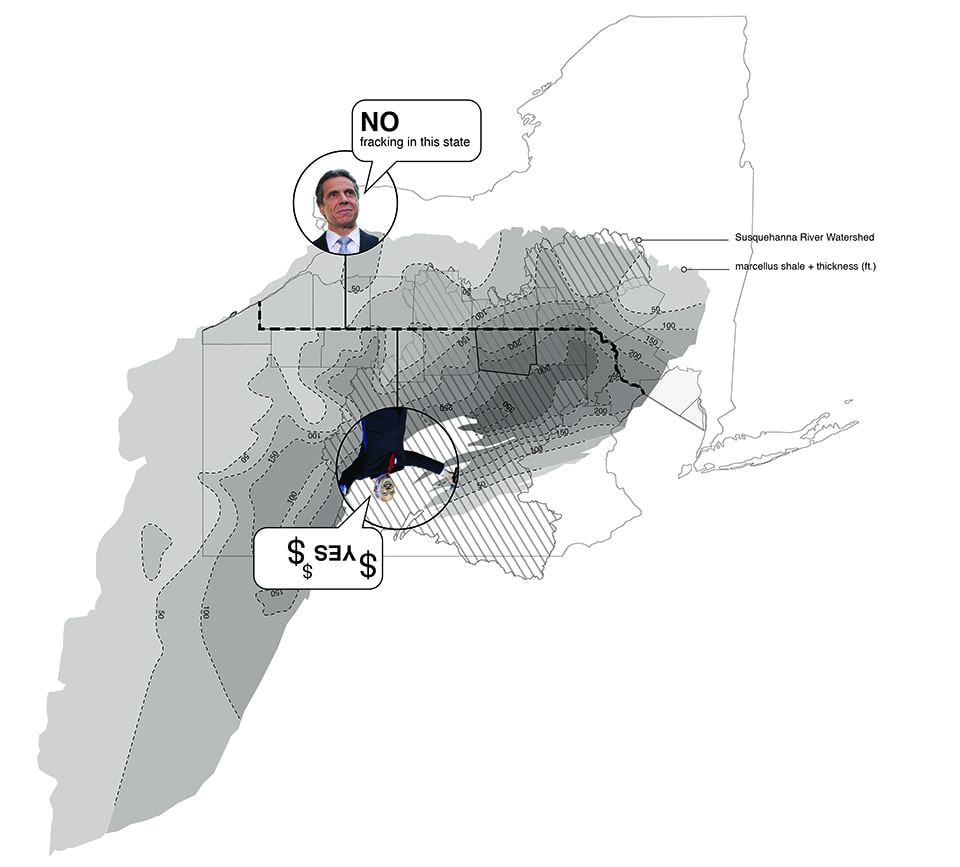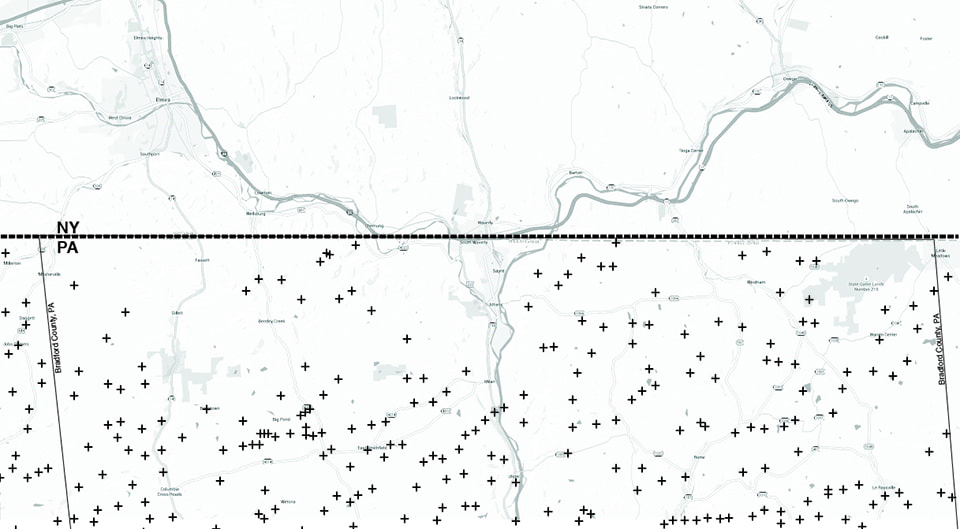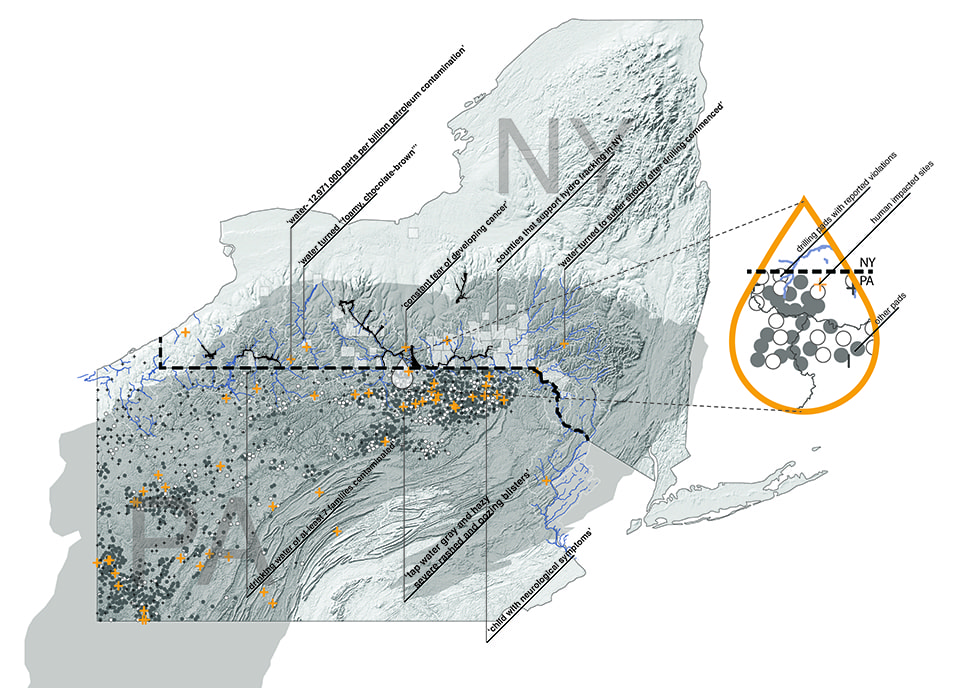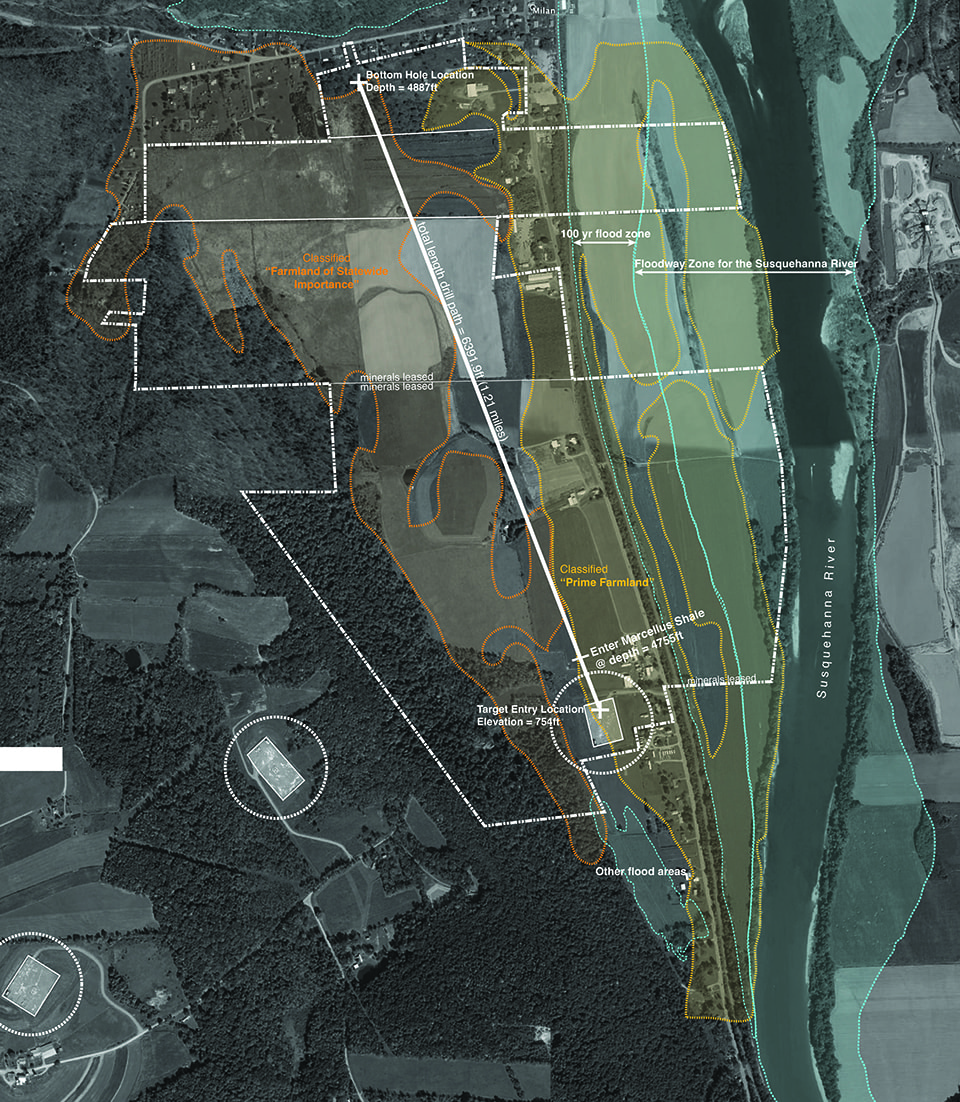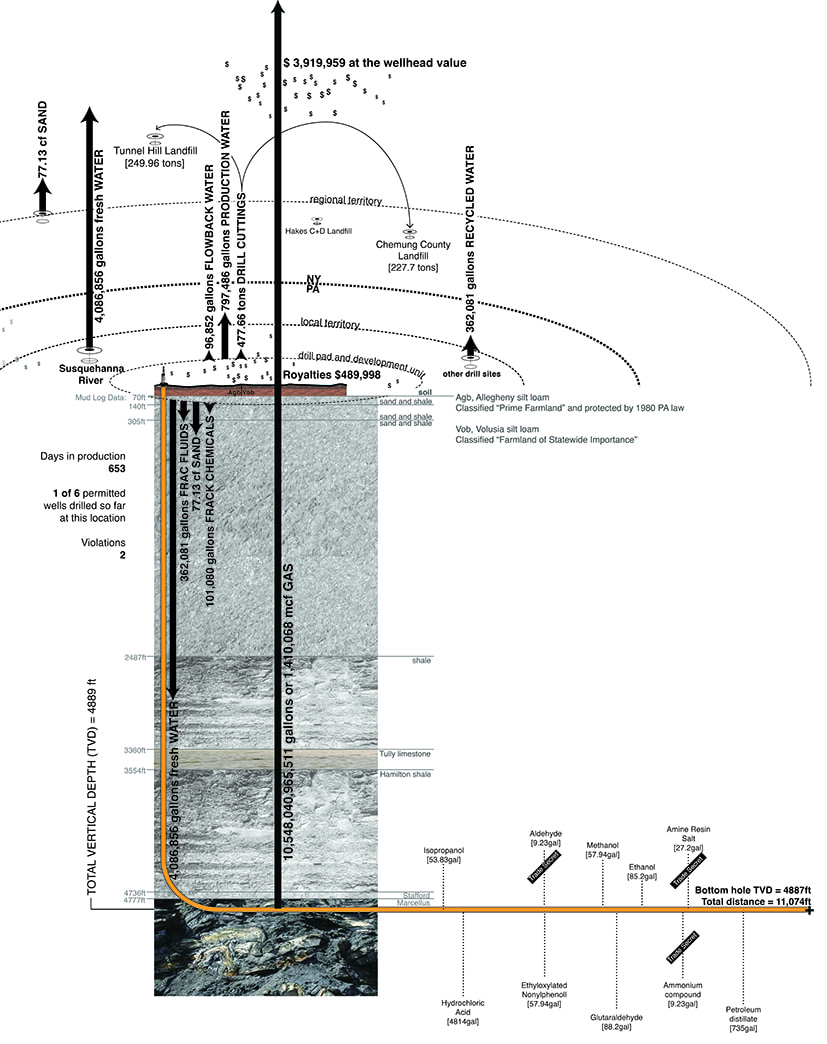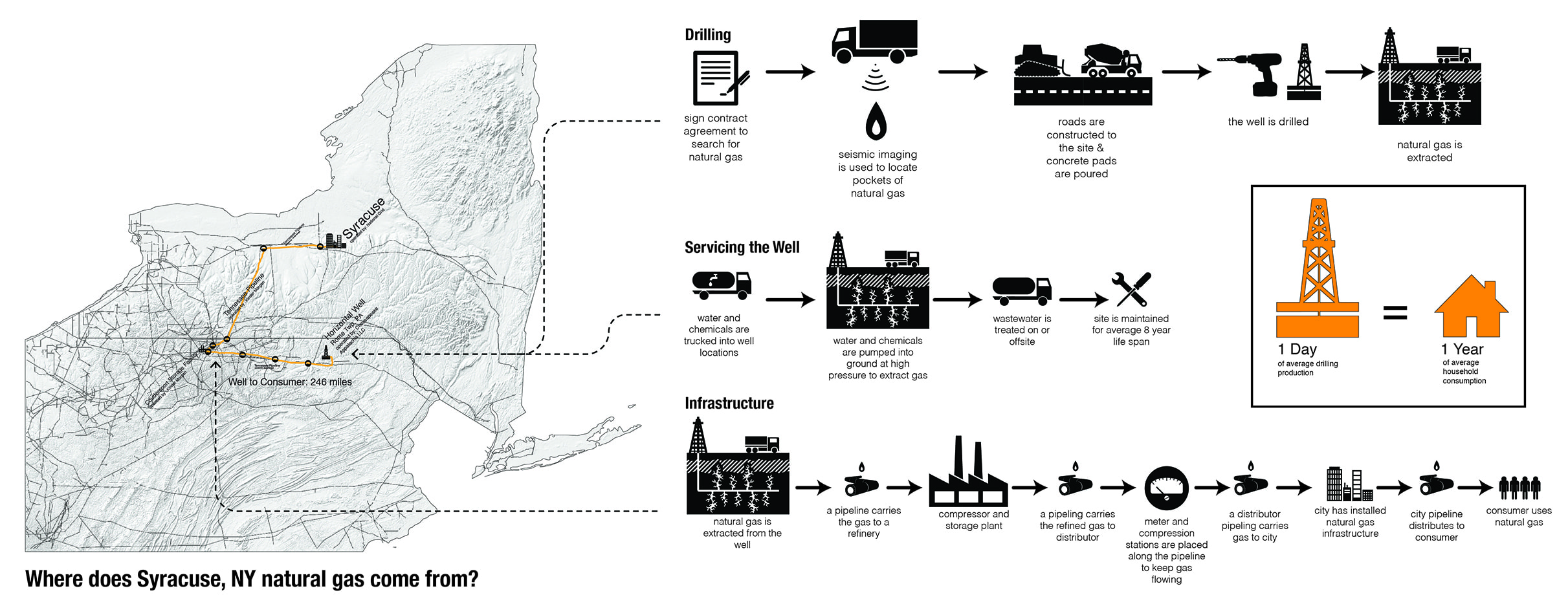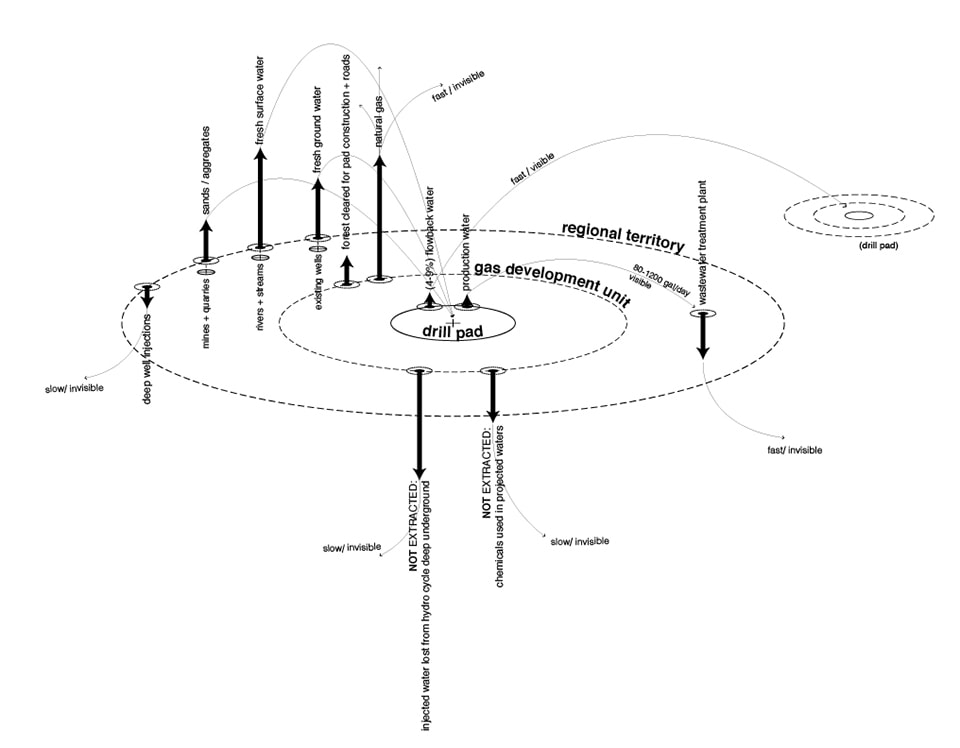Extraction and the Marcellus shale
While gas and oil-rich shale plays are scattered throughout the US, the focus of hydraulic fracturing (or fracking) in the East is an organic-rich, black and slightly radioactive Devonian shale called the Marcellus, which extends across Kentucky, West Virginia, Ohio, Pennsylvania and into the state of New York. A stone reservoir for an estimated 500 trillion cubic feet of natural gas buried one to two miles belowground, the Marcellus could be worth 1 trillion dollars to gas companies and landowners who hold mineral rights to the ancient rock formation [1].
Like all mining practice, fracking is a process of extraction. Descending from a single drill pad located within a “gas development unit,” a vertical well can deploy many horizontal laterals, enabling it to extract gas from an area approximately one mile square. Large volumes of a pressurized slurry of water, sand, acid and chemicals is forced into the well, causing the shale to fracture and release its stored fuel, which is then brought back to the surface. Unlike more isolated mining sites such as copper mines or limestone quarries, the geography of the Marcellus extends across a large region, often consuming privately owned residential and agricultural lands. In order to tap what lies below, gas companies must first assemble an accessible surface via land leases and mineral rights purchases. Maps of the shale play area reveal a patchwork of leased properties interspersed with holdout tracts whose owners fear that drilling will expose them to noise and light pollution, truck traffic, land clearing, or contamination of well water and air. This holey matrix of extraction sits atop forest, field, river and town, and is not discrete and bounded, but rather must be fed by substantial inputs of materials from across the region. Its outflows produce both benefits (jobs, money, natural gas) and liabilities (wastewater, sludge, contaminants) for local residents.
A line runs through it: The territory of gas extraction for the Marcellus shale underlays the watershed of the Susquehanna River. Bisecting the potential extraction zone is a policy line at the NY/PA border. Fracking is banned to the north of this line, while drill sites cluster just south of the border in places like Bradford County, PA.
Drawing a Line
On December 17, 2014, Governor Andrew Cuomo banned the process of hydraulic fracturing for gas production in the state of New York, citing potential environmental and health risks and uncertainties [2]. Just south of the NY/PA border, some of the most intensive drilling occurs in an area where the Marcellus shale is deep, thick and most productive. A visit to northern Pennsylvania, where frack pads are a stone’s throw from “protected” New York lands, is a pleasant drive through rolling hills, farmland and forest. The pads are surrounded by chain link fence, each one rather inconspicuous but growing in presence due to their abundance: drilling pads begin to appear behind barns and on grassy knolls, until there seems to be a pad around nearly every bend in the road. Sightings of pipelines and meter boxes, storage tanks, new gravel access roads and tanker trucks collectively construct a stealthy industrial landscape emerging amidst these sleepy farm pastures.
After years of stalls and scientific studies, documentaries and lobbyists, 55% of New Yorkers breathed a collective sigh of relief with Cuomo’s sudden announcement of a fracking ban [3]. But how powerful is a policy line? Heading home from a Pennsylvania drill site behind a tanker truck as it crosses the border into New York without fanfare, one wonders about the power of this ban, this border. Where is this regulatory boundary solid and strong and where is the line blurred, perforated, or not really there at all?
A graded drill pad sits nestled on a small knoll amidst pastures and farm fences. (Photo by Dylan Hartung)
Flows and Lines
Water Flows: It takes between 4.1 million and 5.6 million gallons of water to frack a single Marcellus well [4]. While the usage of recycled water by gas producers is on the rise, it is still small compared to the amount of freshwater that must be extracted from surface or groundwater sources, rarely topping 15% of the total water needed for the fracking operation [5]. Water is typically trucked to well sites in water tankers from around the state and from across the border. In a decidedly anti-extractive process, the water/sand/chemical mixture is forced into the well, and only a small percentage (between 4% and 9% for Bradford County wells) returns to the surface as “flowback”, wastewater that returns to the surface during the drilling of a well before it has begun producing. Between 2008 and the beginning of 2013, 6 billion gallons of surface and ground water was injected into the ground in the Pennsylvania portion of the Susquehanna River basin alone [6].
Just across the line: A snapshot of the NY/PA border at Bradford County, Pennsylvania reveals the density of drill pads just south of the border.
Most of this water is pushed so deeply underground that it is effectively removed from the hydrologic cycle. The 80-1200 gallons of production water that returns daily over the life of the well is a briny mix containing chemical additives along with various constituents of the shale, including salts, organic pollutants, and radioactive ions such as uranium. This wastewater must be managed on site in storage ponds and tanks, trucked to municipal wastewater or industrial facilities, or sometimes injected deep into retired wells. Questions have been raised about the ability of Pennsylvania wastewater treatment plants, designed to handle human sewage, to rehabilitate the flow of 2,564,700 gallons of frack wastewater every day [7]. Further, these plants discharge “treated” waters to rivers throughout the state, including the Susquehanna, in an efficient distribution network for any remaining contaminants, including radioactive ions. Wastewater brine has even been distributed on New York’s roadways to prevent icing in winter [8].
The amorphous underworld of water: Groundwater continuously flows and seeps, operating by its own rules and ignoring political boundaries on the surface. Following the laws of pressure and potential, groundwater can accelerate when passing through unconsolidated sediment or slow and pool as the substrate tightens. It can flow significant distances in days or remain underground for many thousands of years. It can rise to the surface as a spring or intersect with surface waters to feed streams, wetlands or ponds. Rural water wells in NY and PA rely on shallow groundwater and typically do not exceed 500 feet in depth. To access the shale, producers must drill through these shallow aquifers and then line the well with concrete to provide a barrier between fracking fluids and drinking water just inches away. This concrete casing is key to preventing the migration of chemicals and methane into groundwater, from where it could enter rural wells, pipes and kitchen sinks. Drillers claim that well water is safe, although a quick scan of pad violation notices reveals numerous surface spills, illegal dumping and concrete casing failures. Signs of trouble are sometimes only revealed when we turn on the tap.
Material Flows: Hydraulic fracturing requires the construction of a support infrastructure that includes access roads, two-acre concrete drill pads, storage tanks, ponds and pipelines. Flows of sand, gravel, stone and cement sourced from nearby quarries are required to build a network that will carry thousands of tanker trucks and drilling equipment for years. Sand is also a key component of the injection fluid, 12-14% by volume or over 65,000 cubic feet per well. Sand is used as a proppant during fracking to hold fissures open and help the gas to flow. Fine silica sands have become the preferred proppant of the fracking industry, implicating territories as far away as Minnesota, Wisconsin, and Illinois, where agricultural and forested land that sits atop silica sand deposits is being displaced in favor of vast sand mines. This other extraction landscape in the Midwest is set to grow as fracking operations in the Marcellus shale, as well as in other shale plays in the US, continue to accelerate.
The primary way to move these materials to drill sites is via truck. This incredible hauling of materials, water, and wastewater around the region means that dump trucks, tractor trailers and tankers (2300-4000 per well site) [9] are one of the most visible and constant flows associated with gas production in the Marcellus shale play. In the creation of fracking’s access infrastructure, Pennsylvania’s forests have seen extensive collateral damage. Aerial imagery just south of the NY/PA border makes plain the extent to which the drill pad/access road network has shredded forest cover in this region, exhibiting “a greater impact on natural ecosystems than activities such as logging or agriculture” [10]. With the danger of subsequent erosion and the impact on water regimes that forest losses pose, the access network may leave an even larger impact on the watersheds of Pennsylvania over the long term.
Drawings collect and organize disparate bits of data to assemble the flows of one drill site in Bradford County, PA. Here the first of 6 permitted wells is located on prime farmland soils, near the floodplain and channel of the Susquehanna River. 5,127,318 gallons of fluid were used to frack this well, including 4,086,856 gallons of freshwater withdrawn from the Susquehanna. The drill descended 4777 feet before entering the Marcellus shale formation, with drill cuttings removed from this location trucked across the NY/PA border to be disposed of at the Chemung County and the Tunnel Hill landfills in the southern tier of New York State. After 653 days in production, this site had produced 1,410,068 million cubic feet (MCF) of gas worth $3,919,959 at the wellhead, translating to $489,998 in royalties for the landowners within the unit.
Money Flows: The line does mean that landowners on the New York side will not profit from gas that could have been produced on their properties (although many have already benefited financially via gas leases). Reports have shown that Cuomo’s ban eliminated 50,000 potential jobs tied to the fracking industry. In Pennsylvania gas drilling has generated approximately 229,000 jobs, $2.2 billion in tax revenues so far. Initially most jobs went to out-of-towners from the industry, but increasingly, in-state residents are being trained to work in gas production. Businesses supporting the industry, such as restaurants and hotels, are also prospering. The power of the line is perhaps most potent and its effects most palpable when blocking the flow of gas royalties in New York. As Karen Moreau, the executive director of the New York State Petroleum Council puts it “Our citizens in the Southern Tier [of New York] had to watch their neighbors and friends across the border in Pennsylvania thriving economically…It’s like they were a kid in a candy store window” [11].
Flowing freely across the line: infrastructural connections, direct to consumers. Ideologies aside, consumers in NY still reap the benefits of having drill sites just next door. In fact, the price New Yorkers pay to heat their homes has fallen steadily since 2008 [12] as gas production has increased in Pennsylvania. The fact that natural gas is a local market means that as local production increases, local prices fall [13]. It can be difficult, if not impossible, to trace the flow of the gas used to heat a home in Syracuse, NY back to its source. National Grid, the New York home electric and gas company, purchases its gas from distributors and can’t (or won’t) tell a customer for certain where their gas originates. A dense network of pipelines (shown here in gray) both collects and distributes natural gas throughout the region. This gas typically does not require refining, so the fuel can flow fairly freely from drill site to home furnace. We trace one possible pathway from a drill pad in Rome township, to a storage facility 246 miles, to one of the authors’ homes in Syracuse.
The landscape of extraction constructed by the process of hydraulic fracturing of the Marcellus shale is a special case. Nowhere else in the US do we see mining practice sharing territory with multiple parallel landscape systems, from watersheds and water flows, to habitats and species migrations, households and drinking water, extensive farms and working forests. Fracking draws large material and human inputs from a regional geography freely across borders and legislative lines. Its outflows likewise extend back out to the region and beyond, along existing regional infrastructures and natural systems. The flows of fracking can be fast (such as the influxes of industry personnel) or exceedingly slow (deep subterranean water flows). They can be visible (trucks, jobs, money) or invisible (groundwater pollution, cumulative contamination downstream). The power of a policy line at the NY/PA border varies greatly. The line is weak when it seeks to block flows that are unregulated, uncontrollable, or unseen: deep groundwater, injected water, truck traffic, jobs, land speculation, gas, illness, political ideologies, complaints and perceptions.
We are accustomed to living within a set of visible surface systems: hedgerows and cornfields, mowed utility easements and fenced property lines. But so much of the process of fracking is undisclosed: neighbors’ leases, health complaints, tainted wells, chemical lists and wastewater disposal sites have been concealed due to legalities. The connection between people and the extraction process occurring in their backyards and home places is obscured because most of it occurs behind closed doors and underground, in the alien, dark world of rock and soil, groundwater flows and methane migration. While producers can’t legally extend wells under unleased lands, would anyone know if they did? How does a landowner really know what is happening 2,000-8,000 feet underground? While the surface drill pad site is undeniably noisy, dusty and brightly lit, public knowledge of subsurface drill pathways only exists on the survey plat or engineering drawing as a plan, proposal, or promise.
Although drilling companies are increasingly pressured to release details previously considered proprietary, this information is scattered, buried and sometimes requires fees to access. Every drill pad has a specific and living dataset that includes a driller’s mud log, associated water withdrawal sites, mineral rights leases and contracts, and letters detailing tainted drinking water wells, waste water recycling sites, drill cutting disposal locations, gas produced, royalties paid, frack chemicals used and distances from drill pad to nearby drinking water wells. Mapping and visualizing the processes of gas drilling makes visible the flows that are normally obscured. It brings to light processes that occur below ground, without notice, or without public access. As more information is disclosed and made accessible, drawing and spatializing the complex and scattered bits of data is essential in order to construct a fuller understanding of a dispersed landscape of extraction and its hidden impacts.
The flows of fracking: Risks associated with the process of hydraulic fracturing are often related not to what comes out, but what goes in and stays in. A large percentage of injected slurry, along with its suite of chemicals and carcinogens, never returns to the surface. Fracking in Pennsylvania has reportedly forced 1% of the state’s total surface waters downward and out of the hydrologic cycle for what may be millennia [14]. Meanwhile wastewater that is extracted at the surface must be either treated with ill-equipped infrastructure and released to surface waters, or pumped into deep wells. Flows vary from the fast and visible to the very slow and unseen.
 Jamie Vanucchi is an assistant professor in the department of landscape architecture at Cornell University (previously SUNY-ESF). This work was prepared with students of the SUNY-ESF Design Lab for NY Waters, including: Ben Boisclair, Gena Morgis, Emma Oakes, Amy Allen, Kimie Case, Liz Grades, Rose Helmer, Chris Kraus, Billy O’Brien, Emma Oakes, Victor Prieto, Chris Rurkowski, Rachel Scudder.
Jamie Vanucchi is an assistant professor in the department of landscape architecture at Cornell University (previously SUNY-ESF). This work was prepared with students of the SUNY-ESF Design Lab for NY Waters, including: Ben Boisclair, Gena Morgis, Emma Oakes, Amy Allen, Kimie Case, Liz Grades, Rose Helmer, Chris Kraus, Billy O’Brien, Emma Oakes, Victor Prieto, Chris Rurkowski, Rachel Scudder.
Notes
[1] Penn State Marcellus Center for Outreach and Research, “How Much Natural Gas can the Marcellus shale produce?,” accessed August 6, 2015, http://www.marcellus.psu.edu/news/PDFs/gasreserves_day.pdf.
[2] Thomas Kaplan, “Cuomo Bans Fracking, Saying Risks Trump Economic Potential,” New York Times, December 18, 2014.
[3] Scott Waldman, “Poll: New York Voters support Cuomo’s Ban on Fracking,” Politico New York, Dec. 22, 2014, http://www.capitalnewyork.com/article/albany/2014/12/8559092/poll-new-york-voters-support-cuomosban-fracking).
[4] Evan Hansen, Dustin Mulvaney, and Meghan Betcher, “Water Resource Reporting and Water Footprint from Marcellus Shale Development in West Virginia and Pennsylvania,” prepared for Earthworks Oil & Gas Accountability Project by Downstream Strategies and San Jose State University (2013): 9, http://www.downstreamstrategies.com/documents/reports_publication/marcellus_wv_pa.pdf.
[5] This percentage based on author’s review of well reports for Bradford County.
[6] Hansen, Mulvaney, and Betcher, 58.
[7] “Marcellus Shale wastewater: Current discharges,” Pittsburgh Post Gazette, March 13, 2011, 7, accessed August 6, 2015, http://old.post-gazette.com/pg/pdf/201103/20110313marcellus_discharge.pdf.
[8] David L. Shaw, “Farmer objects to fracking brine on roadways,” Finger Lakes Times, November 18, 2014, http://www.fltimes.com/news/article_6cfb4e7a-6f33-11e4-870b-0bbc03e63e9f.html.
[9] Mary Ellen Cassidy, “Here They Come Again! The Impacts of Oil and Gas Truck Traffic,” September 11, 2014, FracTracker Alliance, http://www.fractracker.org/2014/09/truck-counts/.
[10] “U.S. Geological Survey: Natural Gas Fracking Is Destroying Pennsylvania Forests,” Oct 24, 2012, Natural Gas Watch, http://www.naturalgaswatch.org/?p=1565.
[11] Kaplan.
[12] Jesse Emspak, “How Fracking Affects Natural Gas Prices,” August 8, 2014, Investopedia, http://www.investopedia.com/articles/markets/080814/how-fracking-affects-natural-gas-prices.asp.
[13] Ibid.
[14] Hansen, Mulvaney, and Betcher, 10.

